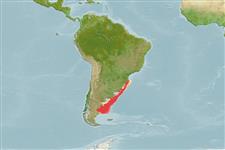Common names from other countries
Elasmobranchii (hajar och rockor) (sharks and rays) >
Carcharhiniformes (Ground sharks) >
Triakidae (Houndsharks) > Triakinae
Etymology: Mustelus: Latin for weasel, an ancient name for sharks, possibly referring to the pointed snouts, swift movements and/or rapacious feeding behavior of smaller predatory sharks [strictly not tautonymous with Squalus mustelus Linnaeus 1758 since type was designated by the ICZN]. (See ETYFish); schmitti: In honor of American biologist Waldo L. Schmitt (1887-1977), curator of marine invertebrates at the U.S. National Museum, who collected holotype. (See ETYFish).
Environment: milieu / climate zone / depth range / distribution range
Ekologi
marina bottenlevande; havsvandrande (Ref. 51243); djupintervall 60 - 195 m (Ref. 27770). Subtropical; 28°S - 45°S, 66°W - 46°W (Ref. 244)
Southwest Atlantic: southern Brazil to northern Argentina.
Length at first maturity / Size / Vikt / Age
Maturity: Lm 58.3, range 55 - 62 cm
Max length : 92.0 cm TL hane/ej könsbestämd; (Ref. 57911); common length : 60.0 cm TL hane/ej könsbestämd; (Ref. 6077)
Found on the continental shelf. Feeds on crabs and probably other crustaceans, and presumably small fishes. Ovoviviparous (aplacental) with 2 to 7 pups per litter. Size at birth 26 cm. Utilized for human consumption.
Ovoviviparous, embryos feed solely on yolk (Ref. 50449). Distinct pairing with embrace (Ref. 205).
Compagno, L.J.V., 1984. FAO Species Catalogue. Vol. 4. Sharks of the world. An annotated and illustrated catalogue of shark species known to date. Part 2 - Carcharhiniformes. FAO Fish. Synop. 125(4/2):251-655. Rome: FAO. (Ref. 244)
IUCN Red List Status (Ref. 130435)
CITES (Ref. 128078)
Not Evaluated
Threat to humans
Harmless
Human uses
Fiskeri: kommersiellt viktig
Verktyg
Special reports
Download XML
Internet-källor
Estimates based on models
Preferred temperature (Ref.
115969): 4.5 - 14.2, mean 7.9 (based on 118 cells).
Phylogenetic diversity index (Ref.
82804): PD
50 = 0.5000 [Uniqueness, from 0.5 = low to 2.0 = high].
Bayesian length-weight: a=0.00257 (0.00165 - 0.00399), b=3.10 (2.97 - 3.23), in cm Total Length, based on LWR estimates for this species & Genus-body shape (Ref.
93245).
Trofisk nivå (Ref.
69278): 3.6 ±0.3 se; based on diet studies.
Resiliens (Ref.
120179): Mycket låg, lägsta populationsfördubblingstid mer än 14 år (Fec=2-3).
Fishing Vulnerability (Ref.
59153): High vulnerability (58 of 100).
Climate Vulnerability (Ref.
125649): Very high vulnerability (87 of 100).
